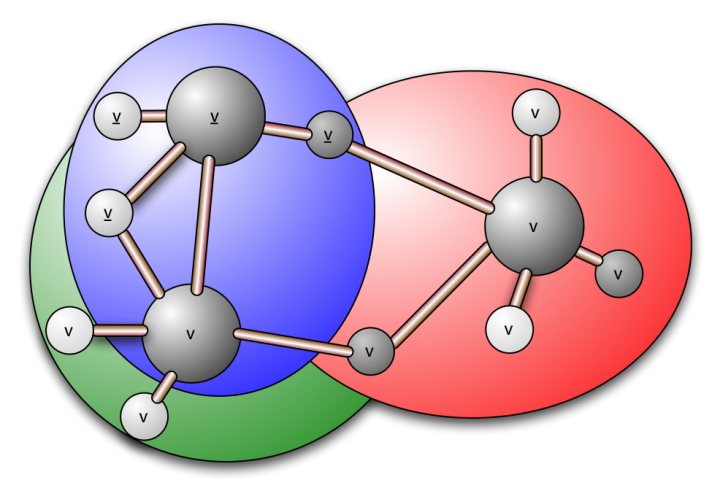Overlapping communities by multiple group membership: quantum behavior in social networks
In social network analysis, a network often looks quite simple, when you zoom in to a certain section. People are nodes, and they are connected to other nodes. Sometimes a connection means friendship, but it could also refer to advice giving, dislikes, knows, etc. etc. I’d like to see a connection as “works together with”, and nodes as people in a certain context, for example a large organization. In organizations nodes often belong to a cluster of nodes resulting in closed networks or clusters where ties are strong, and some nodes connect clusters, making them brokers. These ties are less strong. These networks are often visualized as a snapshot in time for sake of simplicity, and more often than not are overly simplified for readability purposes. Where people in organizational settings used to be member of one or two work-groups, nowadays with the rise in online collaborative spaces this membership is much more dynamic and volatile. Membership is much more voluntary than it is designed, groups emerge and dissolve faster and easier, and resources (knowledge, skills) come more from members themselves instead of the organization. Especially in the online world, albeit in organizational settings, this is and will be the case more often (well, in knowledge intensive organizations that is).
The above results in people being member of more groups than they were before. This can be as a core member in one or more teams, and it can be in the periphery in other teams. In social network terms this results in overlapping communities. There appear many bridges not made up of two different people (nodes), but a single node is forming a bridge by being a member of two or more communities at the same time. This is coined as a “structural fold” by Vedres and Stark (2010) as opposed to a “structural hole” coined by Burt (1992). To me, the “structural fold” is in abstract terms comparable to quantum mechanics. Where atoms in quantum-land can switch positions instantly (well, not exactly, but it can appear that way), people can too, when working with online collaborative tooling. It is common for many people to work at more than one project at the same time, dividing their time on different projects, not always knowing beforehand where to work on at what moment. That makes it possible to bring in knowledge and situations from one project to another almost instantly and by the same person. In network visualizing, there is a world to discover here. When a person connects two groups by being a core member for both, visualization could be relatively easy with Venn-diagrams. However, with more simultaneous multiple group memberships, and with more nodes in the network showing the same behavior, visualizing would be very challenging. I found the image below that illustrates what I’m referring to. The majority of the nodes are member of more than one group at the same time. With these numbers the visualization is good to interpret, but with growing numbers this will be a problem. Try to visualize overlapping communities with more than 10.000 people and hundreds of communities.
We see nodes being connected to other nodes, and being part of multiple groups. In this simplified example it is quite easy to interpret. In a global and large organization this would be quite problematic. Maybe when we add dimensions things would become easier. However, when introducing the quantum behavior as I just mentioned would introduce new difficulties when visualizing. Perhaps we have to let go of a person being a single node, a person can be many nodes at once. Person 1 can be at different ‘places’ simultaneously, and when a person is in which position is unknown, and perhaps irrelevant. The same is the case for person 2, 3, … n-2, n-1 and n. Showing and integrating their networks would be a great challenge. Maybe we can learn from current quantum visualizations. Nodes circling or jumping through network space via hidden dimensions. Although I wouldn’t be too happy when the controversial string theory would enter the social network space… Bottom line: a picture tells a thousand words, but that’s not always enough.
2 Responses
Subscribe to comments with RSS.


One way of designing an application to visualise multiple memberships might be to focus on allowing the user to examine the network from a variety of perspectives. For example, one perspective might be something like the “node” perspective, where there is one node extending into multiple networks. The focus would then be on creating a way to visualise that node’s singular position in multiple networks. The user could then switch to the “network” perspective, where nodes appear more than once but the focus is on examining the relationships between the networks. Over time, as the user examines the networks from a variety of perspectives, they can gain an understanding of how the network comes together as a whole, even though it may not be possible to visualise this in its entirety.
I see you don’t use the power of social websites like pinterest and facebook
on your blog. You can get big traffic from social sites
on autopilot using one useful app, for more details
search in google for:
Alufi’s Social Automation